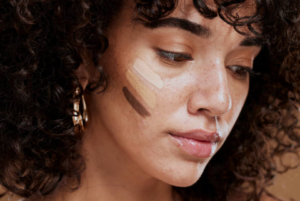Complexion Perfection




Finding the perfect foundation match can feel like searching for a needle in a haystack. With countless shades, formulas, and finishes available, the process can be overwhelming, leaving many feeling frustrated and discouraged. However, fear not! With a few simple tips and tricks, you can navigate the world of foundation with confidence and discover your ideal match. Let’s dive in!
Understanding Your Skin Undertone
Before diving into the world of foundation shades, it’s essential to understand your skin undertone. Undertones are the subtle hues beneath the surface of your skin that influence how colors appear on you. There are three main undertones: cool, warm, and neutral.
- Cool Undertones: If your skin has pink, red, or blue hues, you likely have cool undertones.
- Warm Undertones: Golden, peachy, or yellow tones indicate warm undertones.
- Neutral Undertones: A mix of both cool and warm undertones suggests a neutral undertone.
Determining your undertone is crucial for selecting a foundation that will seamlessly blend with your natural skin tone and enhance your complexion.
Finding Your Shade
Once you’ve identified your undertone, it’s time to find your perfect foundation shade. Here are some tips to help you along the way:
- Consult with Professionals: Visit a beauty counter or makeup store where trained professionals can assist you in finding your perfect match. They can assess your skin undertone and recommend suitable foundation shades from their range of products.
- Test Multiple Shades: Don’t be afraid to swatch! Test several shades along your jawline or the side of your face to see how they blend with your natural skin tone. The right shade should seamlessly disappear into your skin without any noticeable demarcation lines.
- Consider Lighting: Lighting plays a significant role in how foundation shades appear on your skin. Test shades in natural light whenever possible, as artificial lighting can distort colors. If testing indoors, choose an area with ample natural light or bring a small mirror to step outside for a more accurate assessment.
- Observe Oxidation: Some foundations may oxidize or darken slightly upon application. To account for this, swatch a small amount of foundation and allow it to set for a few minutes to observe any changes in color before making your final decision.
- Don’t Forget Your Neck: Your face and neck may have slightly different undertones, so it’s essential to blend your foundation down your neck to ensure a seamless transition and avoid a mismatched appearance.
Choosing the Right Formula and Finish
In addition to finding the perfect shade, consider the formula and finish that best suit your skin type and preferences:
- Liquid Foundations: Liquid foundations offer versatility and are suitable for most skin types. They provide buildable coverage and a natural finish that can be customized to your desired level of coverage.
- Cream Foundations: Cream foundations are ideal for dry or mature skin as they provide hydrating coverage and a dewy finish. They often offer more intense coverage and can help create a smooth, luminous complexion.
- Powder Foundations: Powder foundations are perfect for oily or combination skin types as they absorb excess oil and provide a matte finish. They offer lightweight coverage that can be built up for a more polished look.
- Stick Foundations: Stick foundations are convenient for on-the-go touch-ups and offer medium to full coverage with a creamy texture that blends seamlessly into the skin.
- BB and CC Creams: BB (beauty balm) and CC (color-correcting) creams are lightweight alternatives to traditional foundation. They provide sheer to medium coverage while offering skincare benefits such as hydration, sun protection, and color correction.
Additional Tips for a Flawless Application
Once you’ve found your perfect foundation match, here are some additional tips for achieving a flawless application:
- Prep Your Skin: Start with a clean, moisturized canvas. Apply a lightweight moisturizer suitable for your skin type to ensure smooth, hydrated skin before applying foundation.
- Use the Right Tools: Choose tools that work best for your preferred foundation formula. Use a makeup sponge or beauty blender for liquid or cream foundations and a dense brush for powder formulas.
- Apply in Thin Layers: Less is more! Start with a small amount of foundation and build up coverage as needed to avoid a heavy, cakey finish.
- Blend, Blend, Blend: Blend foundation evenly using gentle, outward strokes to ensure seamless coverage. Pay extra attention to areas such as the jawline and hairline to avoid harsh lines.
- Set with Powder: For long-lasting wear, set your foundation with a light dusting of translucent powder. Focus on areas prone to shine, such as the T-zone, to minimize excess oil throughout the day.


Finding your perfect foundation match is a journey worth undertaking. By understanding your skin undertone, testing multiple shades, considering formula and finish options, and mastering application techniques, you can achieve a flawless complexion that enhances your natural beauty. Remember, makeup is a form of self-expression, so have fun experimenting and embrace the process of discovering what works best for you. With these tips in hand, you’re well on your way to complexion perfection!

